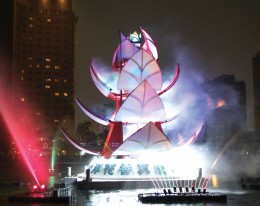A Visual Feast-Kaohsiung Lantern Festival / 愛河花燈 元宵上市
A Visual Feast-Kaohsiung Lantern Festival
Text by Yu-Fong Wang Photos by Jung-Hui Pao
The splendid 2006 Kaohsiung Lantern Festival attracted millions of people to experience this romantic setting along the Love River. The City of Kaohsiung impressed everyone by showing charm and uniqueness through the enthusiasm of its citizens and by its own dynamic: the building of the KMRT and the new stadium for the 2009 World Games.
The Lantern Festival has to be considered as being one of the most significant traditional Chinese festivals. The history behind it, dates back to the Emperor Wu of the Han Dynasty, ruling from 141 BC to 87 BC, when an officer named Shuo Dongfang who wanted to help a desperate servant named Yuan Hsiao who missed her parents so badly, came up with a clever plan, which was to spread the rumor that the Fire God would destroy the whole town unless everyone ate Tang Yuan, lit lanterns and let off firecracker to please him. Shuo Dongfang also advised the Emperor Wu that they must serve the best Tang Yang, a rice dish. The best Tang Yang made by Yuan Hsiano. Later, the inhabitants became grateful to Yuan Hsiao because her Tang Yuan pleased the Fire God and therefore saved them from destruction. Therefore, they named Tang Yang, Yuan Hsiao. It has now become a custom which is passed down from generation to generation. Today, people celebrate the Lantern Festival by enjoying the lantern shows, playing the riddles and eating Yuan Hsiao.
 Taiwan's Lantern Festival follows this tradition and installs its own characteristics; therefore many cities in Taiwan have developed their very own personalities. Among which, Kaohsiung Lantern Festival has won the most acclaim. Many consider it as the highlight of the whole event.
Taiwan's Lantern Festival follows this tradition and installs its own characteristics; therefore many cities in Taiwan have developed their very own personalities. Among which, Kaohsiung Lantern Festival has won the most acclaim. Many consider it as the highlight of the whole event.
The 16 petalled glower shape lantern was chosen as the theme lantern for this year's Lantern Festival. It not only served as the star attraction but also broadcast the fact that Kaohsiung is now a garden city. The opening and closing of the main lantern, symbolize the harmony that exists between the various ethnic groups living in this lovely city.
Another attraction at this year's Lantern Festival was the Pier of Glory-former Pier 13. It was the ideal place for representatives from the three Sister cities-Portland, Seattle and Pusan- to give a fabulous performance every night during the festivities. The city government even paved the wooden path, on the railway track by the Bureau of Public Works, in an attempt to connect Pier 12 and 13 so that people might experience the pleasure of both the ocean and river at the same time.
This year's 6th Kaohsiung Lantern Festival marks the fact that it has become the most widely cerebrated festival in southern Taiwan, and, as always, many people visited the town to enjoy the simultaneous display fireworks and water dancing along the river. Kaohsiung is already planning next year's festival which looks to be even more spectacular than it was this time.
愛河花燈 元宵上市 文/王御風 攝影/鮑忠暉 一年一度的高雄燈會,元宵節循例登場,百萬市民來到愛河畔,享受全台獨一無二的水岸花燈,也讓人體會到「水岸花香」城的熱情與活力。 元宵節是華人最重要的傳統民俗節日之一,關於其由來,最著名的傳說是漢武帝時代,東方朔為了讓一位叫元宵的宮女見到他的父母,所想出的計策。但根據考證,元宵節實際上是從南北朝才開始逐漸形成,到了隋唐時代,成為每年重要的節日。尤其是唐代有宵禁,只有在正月十五日前後3天,取消宵禁的規定,讓人民賞燈,在這3天,無論王公貴族,或是販夫走卒,都會到市區賞燈,每年此刻,格外熱鬧,也讓元宵成為相當重要的節日。 隨著歷代發展,元宵的習俗逐漸豐富,宋代加入了猜燈謎及現代吃的元宵前身,再加上明清的發展,看花燈、猜燈謎、吃元宵,成為一年一度元宵節的必備項目。 台灣的元宵節,承襲自此傳統,只是經過「在地化」改造後,各地都有其特色,其中又以高雄市在愛河畔舉辦元宵燈會,結合水與光,成為台灣最美麗的燈會。 今年的高雄燈會,自2月11日至28日登場,主題為配合市府推動的「水岸花香城」,訂為「水岸花香.真愛高雄」。最受矚目的是由十六片花瓣所建構的花型主燈,意喻高雄市花園城市的美學,以含苞待放的「花」之造型建構而成一個巨大的「花朵」台,透過花瓣閉合開啟及旋轉意寓著高雄市內族群的融合,同時藉由花體的抽象語彙,營造主燈視覺,意喻高雄市花園城市的美學。 除了主燈外,今年高雄燈會的另一大特色,就是原來的軍用13號碼頭,在去年移交給市府改建為「光榮碼頭」後,首度成為燈會主場地,在燈會期間的每個夜晚,主辦單位也特別邀請國內及美國波特蘭市、西雅圖市及韓國釜山等三國姊妹市一流團隊表演,還有未曾開放的鐵路鐵橋也因工務局的積極施作,鋪設木棧道,將12號、13號碼頭聯結,民眾得以悠閒地漫步其中,近距離地體驗高雄河海交界的景觀。 堂堂邁入第六年的高雄燈會,已經成為南台灣最重要的元宵盛會,今年再度吸引全台各地的民眾到愛河觀賞水與光的盛大演出,同時還可以看到市府對港區開發的成果,相信這幅河海共生的美麗夜景,在往後的元宵節,會更耀眼燦爛。 |